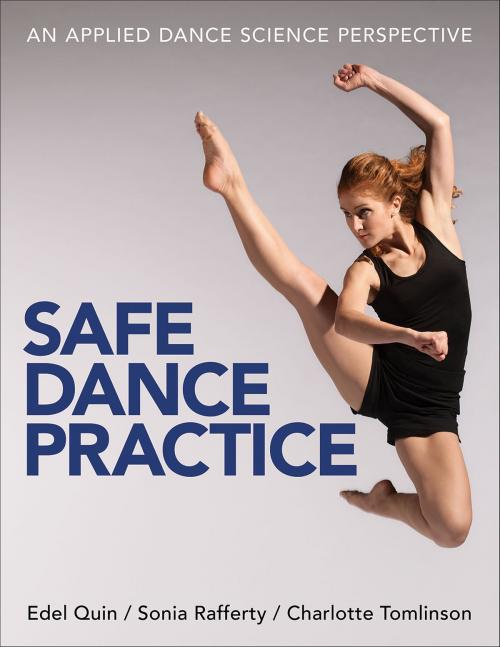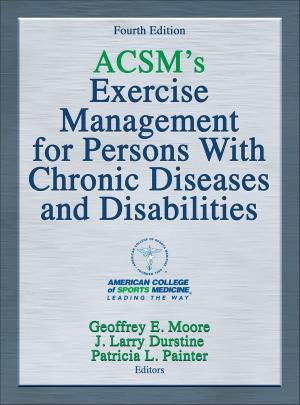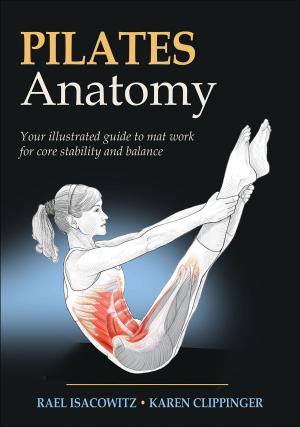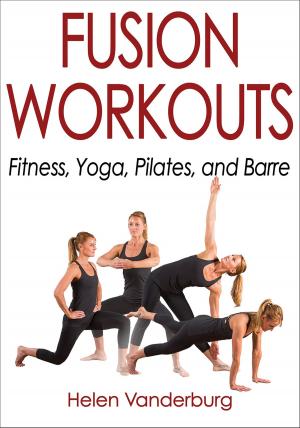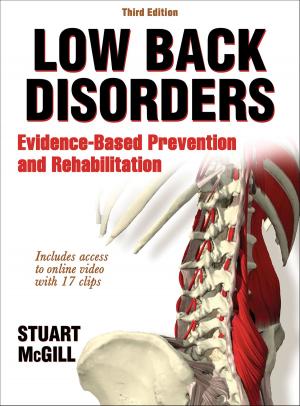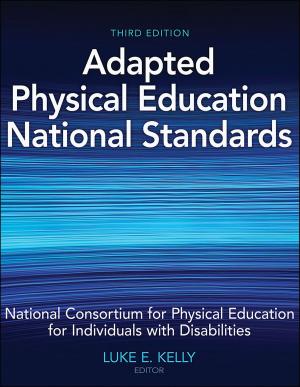| Author: | Edel Quin, Sonia Rafferty, Charlotte Tomlinson | ISBN: | 9781492584865 |
| Publisher: | Human Kinetics, Inc. | Publication: | June 3, 2015 |
| Imprint: | Human Kinetics, Inc. | Language: | English |
| Author: | Edel Quin, Sonia Rafferty, Charlotte Tomlinson |
| ISBN: | 9781492584865 |
| Publisher: | Human Kinetics, Inc. |
| Publication: | June 3, 2015 |
| Imprint: | Human Kinetics, Inc. |
| Language: | English |
Every dancer of every age, ability, and style should be able to engage fully in the act of dancing and be encouraged to achieve their potential without risk of harm to the body or mind. Practical information on all aspects of safe practice that is not too simplistic or complex has not always been easy to find.
Enter Safe Dance Practice, by Edel Quin, Sonia Rafferty, and Charlotte Tomlinson. With nearly 60 years of collective experience in the dance profession as creative artists, teachers, and researchers, the authors translate extensive research and evidence-based practice in order to present the principles of safe practice that are essential to any dance experience.
Guidelines in Implementing Principles
The authors offer evidence-based guidelines on implementing diverse principles in practice, informing and supporting dance practitioners in an ever-growing pool of styles and genres. These guidelines and principles are of use not only to dancers and dance educators but also to choreographers, rehearsal and company directors, and studio managers. The information is underpinned by research in dance science and applied with contextual delivery in mind, ensuring an engaging experience for those accessing the book.
Benefits to Readers
The authors guide readers in these aspects:
• Facilitating a physically and psychologically safe and supportive dance environment
• Understanding principles of anatomy and biomechanically sound alignment
• Implementing effective physiological preparation and progression through warm-up and cool-down protocols as well as supplementary fitness and conditioning
• Minimizing risk of injury and understanding injury management aligned with appropriate rest and recovery strategies
• Incorporating advice on nutrition and hydration for enhanced performance and healthy dance practice
• Tailoring delivery to the specific needs and demographics of participants for diverse engagement with dance
• Evaluating personal practice in order to assess and monitor effective application of the principles
Holistic and Inclusive Approach
Safe Dance Practice takes a multidisciplinary approach to the components of dancing safely, integrating principles without compromising dancers’ artistic creativity and expression. The authors examine not only the immediate variables associated with occurrence of injury but also delve into contributing factors, such as nutrition, alignment, rest and recovery, and supplementary fitness and conditioning.
This comprehensive approach is evident throughout, including a dedicated chapter that will help readers apply the principles to dancers of diverse ages, standards, and physical abilities.
Features of the Book
Safe Dance Practice includes
• diagrams that illustrate ideal and compensated alignment and posture, which readers can apply when assessing all dancers in all genres;
• case studies that help readers contextualize their learning as they see it portrayed in an applied environment;
• at-a-glance chapter summaries and highlighted key points to help readers retain critical information;
• cross-referencing to guide readers to related information in other areas of the book; and
• sources for additional information.
Safe Dance Practice contains 11 chapters, which can be accessed sequentially or studied in any order. The first eight chapters present environmental, anatomical, physical, and psychological principles of safe dance practice. Each chapter includes strategies and examples for putting the principles into practice in relation to dance styles and settings. Chapter 9 focuses on injury awareness and management, and chapter 10 offers guidelines on adapting the principles to a range of dance populations. Chapter 11 helps readers to understand the value of continued monitoring of their practice and includes a checklist of safe practices. Six appendixes supply a series of aids and templates to use as learning resources for ongoing professional development.
This text offers pragmatic recommendations from the authors, who combine scientific fact with experience. The principles are presented in a practical fashion with many specific examples. The take-home messages, checklists, and templates make this text accessible and valuable.
Bridging the Gap Between Science and Practice
Safe Dance Practice bridges the gap between academic research and its application for dancers and educators in all levels and genres. It illuminates the principles of working safely in dance so as to support best practice and encourages all dance practitioners and leaders to better understand, communicate, and apply principles of safe dance practice.
With its applied perspective on dance science, Safe Dance Practice will resonate with readers who want their dance experience to be factually endorsed while allowing sufficient scope for artistic expression. Such evidence-based practice will enable readers to access wider sources of information to aid their ongoing development whilst empowering them to take responsibility for their own safe dance practice and that of others with whom they interact.
Every dancer of every age, ability, and style should be able to engage fully in the act of dancing and be encouraged to achieve their potential without risk of harm to the body or mind. Practical information on all aspects of safe practice that is not too simplistic or complex has not always been easy to find.
Enter Safe Dance Practice, by Edel Quin, Sonia Rafferty, and Charlotte Tomlinson. With nearly 60 years of collective experience in the dance profession as creative artists, teachers, and researchers, the authors translate extensive research and evidence-based practice in order to present the principles of safe practice that are essential to any dance experience.
Guidelines in Implementing Principles
The authors offer evidence-based guidelines on implementing diverse principles in practice, informing and supporting dance practitioners in an ever-growing pool of styles and genres. These guidelines and principles are of use not only to dancers and dance educators but also to choreographers, rehearsal and company directors, and studio managers. The information is underpinned by research in dance science and applied with contextual delivery in mind, ensuring an engaging experience for those accessing the book.
Benefits to Readers
The authors guide readers in these aspects:
• Facilitating a physically and psychologically safe and supportive dance environment
• Understanding principles of anatomy and biomechanically sound alignment
• Implementing effective physiological preparation and progression through warm-up and cool-down protocols as well as supplementary fitness and conditioning
• Minimizing risk of injury and understanding injury management aligned with appropriate rest and recovery strategies
• Incorporating advice on nutrition and hydration for enhanced performance and healthy dance practice
• Tailoring delivery to the specific needs and demographics of participants for diverse engagement with dance
• Evaluating personal practice in order to assess and monitor effective application of the principles
Holistic and Inclusive Approach
Safe Dance Practice takes a multidisciplinary approach to the components of dancing safely, integrating principles without compromising dancers’ artistic creativity and expression. The authors examine not only the immediate variables associated with occurrence of injury but also delve into contributing factors, such as nutrition, alignment, rest and recovery, and supplementary fitness and conditioning.
This comprehensive approach is evident throughout, including a dedicated chapter that will help readers apply the principles to dancers of diverse ages, standards, and physical abilities.
Features of the Book
Safe Dance Practice includes
• diagrams that illustrate ideal and compensated alignment and posture, which readers can apply when assessing all dancers in all genres;
• case studies that help readers contextualize their learning as they see it portrayed in an applied environment;
• at-a-glance chapter summaries and highlighted key points to help readers retain critical information;
• cross-referencing to guide readers to related information in other areas of the book; and
• sources for additional information.
Safe Dance Practice contains 11 chapters, which can be accessed sequentially or studied in any order. The first eight chapters present environmental, anatomical, physical, and psychological principles of safe dance practice. Each chapter includes strategies and examples for putting the principles into practice in relation to dance styles and settings. Chapter 9 focuses on injury awareness and management, and chapter 10 offers guidelines on adapting the principles to a range of dance populations. Chapter 11 helps readers to understand the value of continued monitoring of their practice and includes a checklist of safe practices. Six appendixes supply a series of aids and templates to use as learning resources for ongoing professional development.
This text offers pragmatic recommendations from the authors, who combine scientific fact with experience. The principles are presented in a practical fashion with many specific examples. The take-home messages, checklists, and templates make this text accessible and valuable.
Bridging the Gap Between Science and Practice
Safe Dance Practice bridges the gap between academic research and its application for dancers and educators in all levels and genres. It illuminates the principles of working safely in dance so as to support best practice and encourages all dance practitioners and leaders to better understand, communicate, and apply principles of safe dance practice.
With its applied perspective on dance science, Safe Dance Practice will resonate with readers who want their dance experience to be factually endorsed while allowing sufficient scope for artistic expression. Such evidence-based practice will enable readers to access wider sources of information to aid their ongoing development whilst empowering them to take responsibility for their own safe dance practice and that of others with whom they interact.
